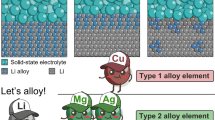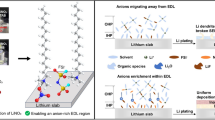Abstract
Oxide-hydrates of molybdenum (OHM) are of interest as lithium insertion electrodes for rechargeable lithium batteries because they offer wide operating temperature, long shelf life and low cost. We have studied the electrochemical characteristics of Li/OHM batteries using two types of commercial materials. Results are as follows. (a) The discharge potential (Φ) ranges between 3.0 and 1.5 V and it is a function of the water content into the cathode. (b) The electro-insertion of Li occurs mainly in two steps in the compositional range 0<x(Li)<1.5. (c) The discharge/charge (Φ-x) curves are very well fitted using a theoretical relationship based on the mean field approximation of a lattice-gas model including an ion-ion interaction term. (d) Kinetics show that Li-ions are highly mobile in the OHM framework. Long-term cycling has been investigated and a detailed analysis of the residual fading capacity during cycling is given.
Similar content being viewed by others
6. References
C. Julien, L. El-Farh, M. Balkanski, O.M. Hussain and G.A. Nazri, Appl. Surf. Sci.65–66, 325 (1993).
K. Hinokuma, A. Kishimoto and T. Kudo, J. Electrochem. Soc.141, 876 (1994).
L. Kihlborg, Arkiv. Kemi21, 357 (1963).
S. Crouch-Baker and P.G. Dickens, Solid State Ionics32–33, 219 (1989).
F.W. Dampier, J. Electrochem. Soc.121, 656 (1974).
N. Margalit, J. Electrochem. Soc.121, 1460 (1974).
J.O. Besenhard and R. Schollhörn, J. Power Sources1, 267 (1976/77).
P.A. Christian, J.N. Carides, F.J. DiSalvo and J.V. Waszczak, J. Electrochem. Soc.127, 2315 (1980).
J.O. Besenhard, J. Heydecke, E. Wudy, H.P. Fritz and W. Foag, Solid State Ionics8, 61 (1983).
N. Kumagal, N. Kumagai and K. Tanno, Electrochim. Acta32, 1521 (1987).
N. Kumagai, N. Kumagai and K. Tanno, J. Appl. Electrochem.18, 857 (1988).
M. Sugawara, Y. Kitada and K. Matsuki, J. Power Sources26, 373 (1989).
C. Julien and G.A. Nazri, Solid State Ionics68, 111 (1994).
W. Weppner and R.A. Huggins, J. Electrochem. Soc.124, 1569 (1977).
J.R. Günter, J. Solid State Chem.5, 354 (1972).
H.R. Oswald, J.R. Günter and E. Dubler, J. Solid State Chem.13, 330 (1975).
S. Basu and W.L. Worrell, in Fast Ion Transport in Solids, edited by P. Vashishta, J.N. Mundy and G.K. Shenoy (North-Holland, Amsterdam, 1979), p. 149.
W.R. McKinnon and R.R. Hearing, in Modern Aspects of Electrochemistry, vol. 15, edited by R. White, J.O'M. Bockris and B.E. Conway (Plenum, New York, 1983), p. 235.
Author information
Authors and Affiliations
Rights and permissions
About this article
Cite this article
Yebka, B., Julien, C. Lithium intercalation in MoO3-nH2O. Ionics 2, 196–200 (1996). https://doi.org/10.1007/BF02376021
Received:
Issue Date:
DOI: https://doi.org/10.1007/BF02376021




